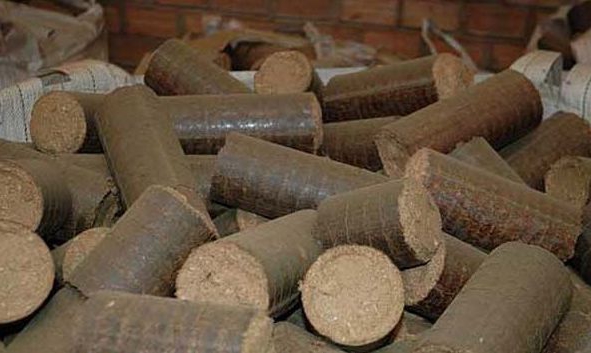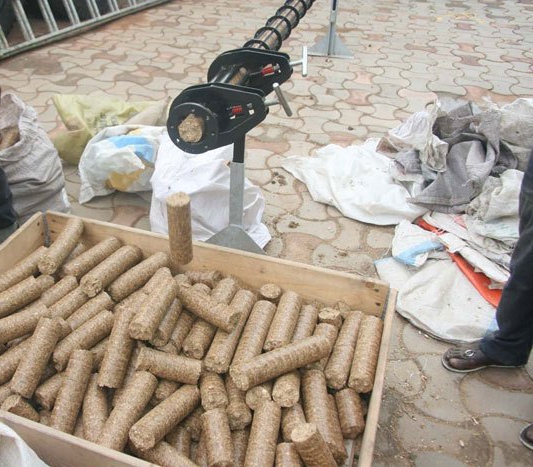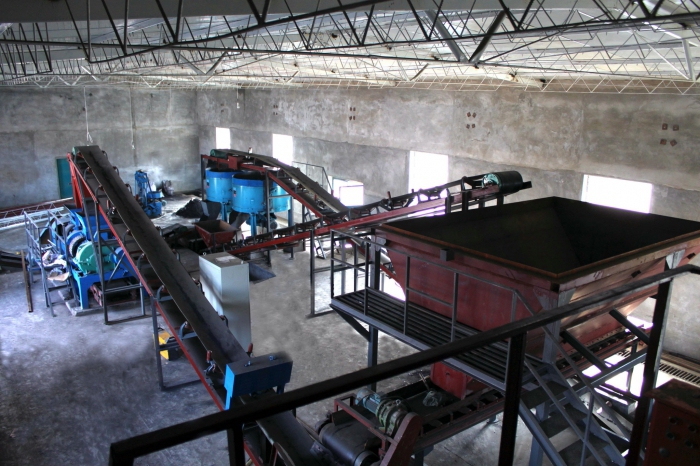 Fuel briquettes - a solid combustible substance that is obtained from wood, as well as other waste vegetation.
Fuel briquettes - a solid combustible substance that is obtained from wood, as well as other waste vegetation.
They are widely used in our time. They are used for various types of furnaces, boilers, and they burn well in fireplaces, grills, stoves.
Wood fuel briquettes do not include harmful substances as well as glue. Specially pressed at high temperature and under high pressure, they resemble a cylinder in shape.
The production of sawdust briquettes is based on the process of pressing woodwork waste, ground wood waste under the influence of high pressure when heated. The connecting chain is the lignin contained in plant cells. Many are wondering how to produce fuel briquettes. This will be described later.
Benefits
The main advantage of this material is the constant during four hours temperature during combustion. Fuel briquettes smoke less, do not spark and do not shoot. Also, their advantage in use is the lowest environmental pollution during combustion in comparison with classical solid fuels with equal calorific value, such as coal, but with fifteen times less ash content (maximum 1%).
This means that when compared with ordinary wood, you can put fuel briquettes in the oven three times less. Moreover, they are able to provide a stable temperature throughout the entire combustion process. This is an important property of the material.
Upon completion of combustion, fuel briquettes become, like ordinary firewood, coal. This allows you to further cook on them a grill or barbecue. The temperature of heating fuel briquettes is higher than that of ordinary firewood, and is almost equal to the temperature of coal.
The advantage of this material is a constant temperature during combustion for four hours. Wood fuel briquettes have a heat transfer of 4400 kcal. This is a considerable indicator. For example, the calorific value of a tree (dry solid mass) is 2930 kcal / kg, for brown coal it is 3910 kcal / kg. Fuel briquettes are environmentally friendly products, because in their manufacture exclude the addition of a variety of additives.
Main features and scope of fuel briquettes
For the manufacture of this material, wood chips, chips, chips or other wood waste, which are natural, are used as raw materials. Comparisons of fuel briquettes from wood with coke, charcoal-anthracite and wood show that they have the highest rate in terms of heat removal ability, and several dozen times lower in case of combustion by CO2 emission.
Burning, this material practically does not leave waste, the ash component in this case is approximately one percent. Using such products, you not only provide continuous continuous burning without sparks and clicks, but also bring much less harm to nature. Therefore, the production of briquettes from sawdust is effective.

These products are used almost everywhere. Fuel briquettes are an alternative cheap biofuel for plants that run on wood, coal, etc. This environmentally friendly material is gaining immense popularity at the present time.
As a result, the fuel business will be profitable.The specified material is used for burning stoves, fireplaces, cooking barbecue, in barbecue, barbecue. At the same time, products burn with the smallest smoke emission, high heat transfer, less sparking.
Do-it-yourself fuel briquette production at home
Of course, buying fuel briquettes is not difficult. Today, you can buy absolutely everything, if the availability of funds allows. However, the production of briquettes from sawdust can be carried out on their own, thereby stocking up on winter extra solid environmentally friendly fuel for the stove. Also, it will save all corners of the economy from excess combustible waste. Therefore, the production of fuel briquettes at home is cost-effective.
The specified material is made of sawdust, wood chips, shavings, straw, husk seeds, dry plant stems, coal dust, fallen leaves of trees. In other words, a variety of small combustible garbage is suitable, which is no longer needed on the farm. The clay component will be regular clay. For 10 kg of fine dry material, one kilogram of clay will be needed. In order to make fuel briquettes equal in shape, fold freely, it is possible to make special cells from boards (for example, from wooden boxes).

Manufacturing steps
In this case, the production of briquettes is carried out in the following order:
- Crushed material is poured into the prepared container (sawdust, wood chips, shavings, straw, husk of seeds, coal dust, dry plant stems, fallen leaves of trees).
- Then clay should be poured.
- After this, add as much water as necessary for easy modeling of the entire mass. This is done individually.
- Next, we sculpt briquettes from the resulting mass or fill the mixture into manufactured molds.
- Then we carefully compress and put everything to dry in the sun.
For the strength of fuel briquettes they are lined with bottom and top with unnecessary paper or rags. After that, everything is pressed together.
Business plan - production of fuel briquettes
Today, more and more attention is paid to renewable energy sources for all kinds of human needs - these are biodiesel for cars, solar panels, wind generators wood and fuel briquettes for heating. The latter differ from ordinary wood with high heat output. Their production uses modern technology. However, first you need to draw up a business plan "Production of fuel briquettes."
As mentioned above, these products are created from all kinds of wood waste, as well as from sunflower husks, peat, and straw. Due to its significant energy efficiency, compactness and environmental friendliness, fuel briquettes are used anywhere –when heating houses, power plants, boiler rooms, etc.
In the manufacture of this material, lignin - a substance that is contained in plants - melts under the influence of pressure and temperature, thereby linking all the particles. In appearance, fuel briquettes are similar to ordinary firewood. They are often called eurodroves. Usually they are about 25 cm long and 10 cm in diameter. Basically, the package contains 12 briquettes. However, if desired, they can be made in various sizes. In this case, you should draw up a business plan for the production of Eurodroves.
Raw material selection
An individual approach is important in this process. The waste from wood processing enterprises will help to realize the production of fuel briquettes from sawdust (this can be a furniture factory, a sawmill, a carpentry workshop, etc.). Sawdust and all kinds of larger wood waste can become raw materials for the manufacture of this biofuel. For example, croaker, trimmings, marriage. An economic advantage in this case is an inexpensive renewable raw material for the production of fuel briquettes.
Sales market
The need for wood fuel briquettes is constantly growing.This is mainly due to their economical use and ease of transportation and storage. In Europe, this type of fuel has been in demand for quite some time. In Russia, this material appeared relatively recently.
However, the market has already begun to take shape, and the fuel business in this area has begun to gain momentum. Therefore, it is possible to take its place in this matter. The good thing is that sources of raw materials for the manufacture of these products can be found in abundance in almost any area of our homeland.
Cottages, country houses, recreation centers - consumers of fuel briquettes - are heated by boilers or fireplaces. Basically, heating facilities are not connected to these facilities or they are significantly outdated and in a worn state. Today you can even buy fuel pellets and eurowood in supermarkets.
A variety of organizations: agricultural enterprises, poultry farms may well become a separate branch for the sale of these products. Almost every enterprise that has boiler houses operates on solid fuel. It will not be difficult to interest these organizations in the procurement of this material. It will only be necessary to calculate the benefits of the transaction. This includes improving the environmental situation in the area of the enterprise’s location and reducing transportation and storage costs. Basically, all current solid fuel boilers can run on this material.
Production and Technology
In the production of fuel briquettes, the following requirements are mainly observed: fractional size of not more than 3 mm and humidity from 9 to 13%. Of course, there is no perfect raw material. And a significant part of it will not meet these requirements. The diverse size of production waste will need to be corrected. It is also important to dry and grind. Everything is pretty simple.
For chopping wood waste, a chipper machine of both domestic and foreign production is suitable. The main indicators of your enterprise will be production volumes and the size of the finished fraction regulated at the output.
For example, for such purposes, a wood waste grinding machine, type 5P-PM, is used. They are loaded into the intake window, where a special mechanism captures them and transfers them to the grinding zone. After splitting, the wood enters the grate, through which the larger finished fragments are sieved. At the exit, we get the sawdust of the required size.
The regrinding and drying of raw materials can be carried out in an AC-3 type plant. Such a machine saves electrical energy due to the simultaneous drying and grinding of waste. Also, for the dryer, you need a heat generator that can work on waste or wood.
Staff recruitment
This process should be taken seriously. It is necessary to recruit labor personnel for the normal operation of the enterprise. The number is calculated depending on production volumes, as well as in accordance with the norms of functioning of the equipment and the number of work shifts.
The determination of staff for the work is carried out taking into account working hours 365 days a year in 3 eight-hour shifts. So, a search is made for the general director, chief accountant, shift supervisor (equipment adjuster), production operator, key workers, support staff, drivers.
Project Stages
In this case, the following will be required:
- Searches for sources of first capital, credit.
- Purchase of equipment and rental of industrial premises.
- Installation work.
- Registration of necessary documents for this type of activity.
- Start of production.
Cost and profit
- Production of fuel briquettes from sawdust has a stable prime cost in the region of 5%.
- The cost of materials and raw materials is 40%.
- Depreciation - 14%.
- Labor costs - 29%.
- The rent is 5%.
- Contributions for compulsory pension insurance - 4%.
- Overhead and overhead costs make up 2.9%.
- Spare parts for equipment - 2%.
- Social insurance - 1.5%.

An enterprise engaged in the production of sawdust briquettes, not exceeding the established working limit, after a five-year period may have a profitability of up to 50%. This is a good indicator in this area of business.
Total
After reviewing the contents of this article, each novice entrepreneur can draw appropriate conclusions and organize the production of sawdust briquettes. In this case, making a business plan is quite simple.









I am from Serbia I am interested to be your representative, distributor of Serbia and the former Republic of Yugoslavia.
Please let me know what the terms of cooperation are.